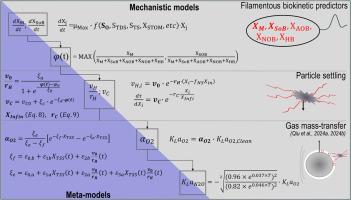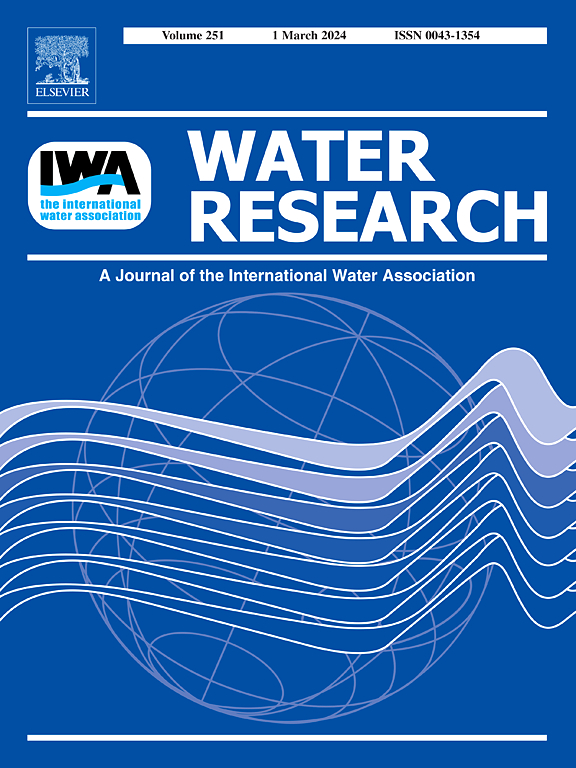Biokinetic soft-sensing using Thiothrix and Ca. Microthrix bacteria to calibrate secondary settling, aeration and N2O emission digital twins
IF 11.4
1区 环境科学与生态学
Q1 ENGINEERING, ENVIRONMENTAL
引用次数: 0
Abstract
Enhancing climate resilience in activated sludge water resource recovery facilities (WRRFs) requires model-based and data-driven decision support and process optimization tools. Traditional data-driven learning methods are widely used for soft-sensor development due to e.g., their simplicity and high predictive accuracy. Unlike for mechanistic models, transferring machine-learning-based insights across systems is largely infeasible, thus hindering communication and knowledge sharing amongst practitioners. To harness the benefits of both approaches, this study introduces a mechanistic online soft-sensor (MOSS) developed to calibrate digital twins of secondary settling tanks (SSTs), aeration systems and nitrous oxide (N2O) emission. MOSS integrates biokinetic models of filamentous microbial predictors to calibrate digital twins through meta-models (data-driven part), updated using offline settling column tests and amplicon sequencing data for microbial analysis. For the first time, this approach employs multi-filamentous-community predictors for dynamic calibration, i.e., Thiothrix and Ca. Microthrix. The effectiveness of the MOSS method is demonstrated using simulations of experimental data from a laboratory-scale WRRF.

利用硫thrix和Ca. Microthrix细菌进行生物动力学软测量,校准二次沉降、曝气和N2O排放数字双胞胎
增强活性污泥水资源回收设施(WRRFs)的气候适应能力需要基于模型和数据驱动的决策支持和流程优化工具。传统的数据驱动学习方法因其简单、预测精度高等优点被广泛应用于软测量开发。与机械模型不同,跨系统转移基于机器学习的见解在很大程度上是不可行的,从而阻碍了从业者之间的沟通和知识共享。为了利用这两种方法的优势,本研究引入了一种机械在线软传感器(MOSS),用于校准二次沉淀池(SSTs)、曝气系统和一氧化二氮(N2O)排放的数字孪生体。MOSS集成了丝状微生物预测因子的生物动力学模型,通过元模型(数据驱动部分)校准数字双胞胎,使用离线沉降柱测试和扩增子测序数据进行微生物分析。该方法首次采用多丝状群落预测因子进行动态校准,即Thiothrix和Ca. Microthrix。通过实验室规模WRRF的实验数据模拟,证明了MOSS方法的有效性。
本文章由计算机程序翻译,如有差异,请以英文原文为准。
求助全文
约1分钟内获得全文
求助全文
来源期刊

Water Research
环境科学-工程:环境
CiteScore
20.80
自引率
9.40%
发文量
1307
审稿时长
38 days
期刊介绍:
Water Research, along with its open access companion journal Water Research X, serves as a platform for publishing original research papers covering various aspects of the science and technology related to the anthropogenic water cycle, water quality, and its management worldwide. The audience targeted by the journal comprises biologists, chemical engineers, chemists, civil engineers, environmental engineers, limnologists, and microbiologists. The scope of the journal include:
•Treatment processes for water and wastewaters (municipal, agricultural, industrial, and on-site treatment), including resource recovery and residuals management;
•Urban hydrology including sewer systems, stormwater management, and green infrastructure;
•Drinking water treatment and distribution;
•Potable and non-potable water reuse;
•Sanitation, public health, and risk assessment;
•Anaerobic digestion, solid and hazardous waste management, including source characterization and the effects and control of leachates and gaseous emissions;
•Contaminants (chemical, microbial, anthropogenic particles such as nanoparticles or microplastics) and related water quality sensing, monitoring, fate, and assessment;
•Anthropogenic impacts on inland, tidal, coastal and urban waters, focusing on surface and ground waters, and point and non-point sources of pollution;
•Environmental restoration, linked to surface water, groundwater and groundwater remediation;
•Analysis of the interfaces between sediments and water, and between water and atmosphere, focusing specifically on anthropogenic impacts;
•Mathematical modelling, systems analysis, machine learning, and beneficial use of big data related to the anthropogenic water cycle;
•Socio-economic, policy, and regulations studies.
 求助内容:
求助内容: 应助结果提醒方式:
应助结果提醒方式:


